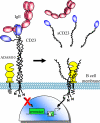The emergence of ADAM10 as a regulator of lymphocyte development and autoimmunity
- PMID: 21236490
- PMCID: PMC3083477
- DOI: 10.1016/j.molimm.2010.12.005
The emergence of ADAM10 as a regulator of lymphocyte development and autoimmunity
Abstract
Proteolytic processing of transmembrane receptors and ligands can have a dramatic impact on cell signaling processes and subsequent cellular responses, including activation and differentiation. A member of the disintegrin and metalloproteinase family, ADAM10, has emerged as a prominent regulator of numerous receptors and ligands, including Notch and CD23. Here, we review studies resulting from the recent generation of ADAM10 conditional knockout mice which revealed a critical role for ADAM10 in Notch-dependent lymphocyte development. Additionally, we discuss results of numerous in vitro and ex vivo studies indicating that ADAM10 regulates the production of multiple secreted factors that contribute to autoimmune reactions.
Copyright © 2010 Elsevier Ltd. All rights reserved.
Figures

 , nuclear localization
, nuclear localization  , transactivating (TAD)
, transactivating (TAD)  , EGF-repeat
, EGF-repeat  ,and PEST domains
,and PEST domains  . Transport of the N2ICD to the nucleus followed by binding to the transcription factor, RBP-Jĸ, allows the release of co-repressors (CoR), and attraction of co-activators (CoA) to the transcriptional complex. The activated complex transcribes Notch target genes, including CD21/35, Deltex-1, Hes 1, and Hes 5, that promote development of marginal zone B cells. Deletion of ADAM10, Notch2, and RBP-Jĸ from B cells, or Delta-like 1 from stromal cells prevents marginal zone B cell development.
. Transport of the N2ICD to the nucleus followed by binding to the transcription factor, RBP-Jĸ, allows the release of co-repressors (CoR), and attraction of co-activators (CoA) to the transcriptional complex. The activated complex transcribes Notch target genes, including CD21/35, Deltex-1, Hes 1, and Hes 5, that promote development of marginal zone B cells. Deletion of ADAM10, Notch2, and RBP-Jĸ from B cells, or Delta-like 1 from stromal cells prevents marginal zone B cell development.

Similar articles
-
ADAM10 is essential for Notch2-dependent marginal zone B cell development and CD23 cleavage in vivo.J Exp Med. 2010 Mar 15;207(3):623-35. doi: 10.1084/jem.20091990. Epub 2010 Feb 15. J Exp Med. 2010. PMID: 20156974 Free PMC article.
-
The emerging role of ADAM metalloproteinases in immunity.Nat Rev Immunol. 2018 Dec;18(12):745-758. doi: 10.1038/s41577-018-0068-5. Nat Rev Immunol. 2018. PMID: 30242265 Review.
-
A disintegrin and metalloproteinase 10 regulates antibody production and maintenance of lymphoid architecture.J Immunol. 2011 Nov 15;187(10):5114-22. doi: 10.4049/jimmunol.1102172. Epub 2011 Oct 12. J Immunol. 2011. PMID: 21998451 Free PMC article.
-
The immunoregulator soluble TACI is released by ADAM10 and reflects B cell activation in autoimmunity.J Immunol. 2015 Jan 15;194(2):542-52. doi: 10.4049/jimmunol.1402070. Epub 2014 Dec 10. J Immunol. 2015. PMID: 25505277 Free PMC article. Clinical Trial.
-
Part-time alpha-secretases: the functional biology of ADAM 9, 10 and 17.Curr Alzheimer Res. 2008 Apr;5(2):187-201. doi: 10.2174/156720508783954686. Curr Alzheimer Res. 2008. PMID: 18393804 Review.
Cited by
-
ADAM10 is required for SCF-induced mast cell migration.Cell Immunol. 2014 Jul;290(1):80-8. doi: 10.1016/j.cellimm.2014.05.005. Epub 2014 May 21. Cell Immunol. 2014. PMID: 24950026 Free PMC article.
-
Identification of genes expressed in the migrating primitive myeloid lineage of Xenopus laevis.Dev Dyn. 2016 Jan;245(1):47-55. doi: 10.1002/dvdy.24314. Epub 2015 Nov 20. Dev Dyn. 2016. PMID: 26264370 Free PMC article.
-
Regulation of α-secretase ADAM10 expression and activity.Exp Brain Res. 2012 Apr;217(3-4):343-52. doi: 10.1007/s00221-011-2885-7. Epub 2011 Oct 4. Exp Brain Res. 2012. PMID: 21969210 Review.
-
A CD21 low phenotype, with no evidence of autoantibodies to complement proteins, is consistent with a poor prognosis in CLL.Oncotarget. 2015 Oct 20;6(32):32669-80. doi: 10.18632/oncotarget.5404. Oncotarget. 2015. PMID: 26452134 Free PMC article.
-
The ADAMs family of proteases as targets for the treatment of cancer.Cancer Biol Ther. 2016 Aug 2;17(8):870-80. doi: 10.1080/15384047.2016.1177684. Epub 2016 Apr 26. Cancer Biol Ther. 2016. PMID: 27115328 Free PMC article. Review.
References
-
- Abel S, et al. The transmembrane CXC-chemokine ligand 16 is induced by IFN-gamma and TNF-alpha and shed by the activity of the disintegrin-like metalloproteinase ADAM10. J. Immunol. 2004;172:6362–6372. - PubMed
-
- Amour A, et al. The in vitro activity of ADAM-10 is inhibited by TIMP-1 and TIMP-3. FEBS Lett. 2000;473:275–279. - PubMed
-
- Anderegg U, et al. ADAM10 is the constitutive functional sheddase of CD44 in human melanoma cells. J. Invest Dermatol. 2009;129:1471–1482. - PubMed
-
- Arduise C, et al. Tetraspanins regulate ADAM10-mediated cleavage of TNF-alpha and epidermal growth factor. J. Immunol. 2008;181:7002–7013. - PubMed
-
- Bazan JF, et al. A new class of membrane-bound chemokine with a CX3C motif. Nature. 1997;385:640–644. - PubMed
Publication types
MeSH terms
Substances
Grants and funding
LinkOut - more resources
Full Text Sources
Miscellaneous

